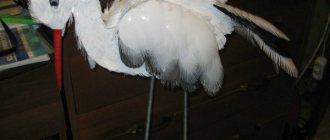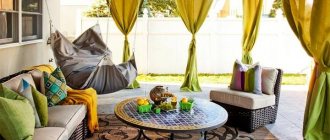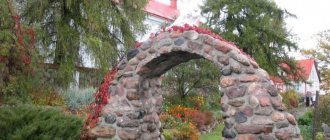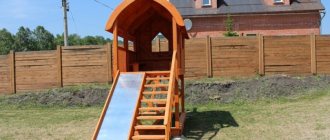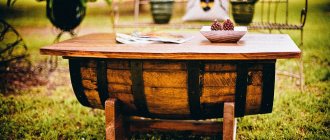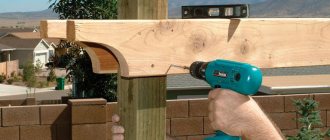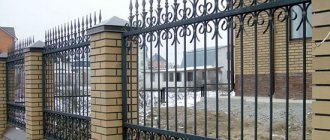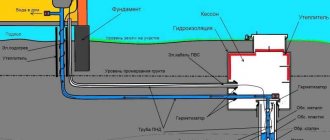It's no secret that you can add an attractive outside world to a country house with the help of a flower bed. Floral arrangements in front of the house can not only become a real aesthetic decoration, but also saturate the house with freshness and a pleasant aroma. In order for the flowerbed to have a complete look, it is usually placed in the front garden. This is not only convenient in terms of irrigation and caring for flowers, but also beautiful in appearance.
Typical wrought iron fence for a front garden
What is a front garden and what are its functions?
The custom of decorating garden plots with flower beds has long come to us, but there was also a special place in front of the house, which was decorated with the best flowers - this is the front garden. Today, arranging a front garden is no less important than in those days.
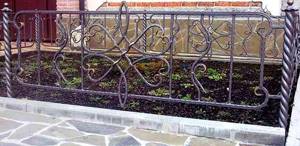
Option for installing a forged front garden
A wrought-iron mini-fence in front of the house can protect the front garden from mechanical influences, and will also allow passers-by to demonstrate the beauty of flowering plants. Such fences are structures ranging in size from 30 cm to three meters that are supported by support pillars. The weight of such elements can be very diverse, depending on the metal used and density. Large fences must have a foundation and mandatory concreting of fence posts, which will eliminate the possibility of the structure collapsing.

Example of a concrete foundation for a front garden
- Protective - the front garden must be fenced and protected from ill-wishers.
- Aesthetic – wrought iron fences should attract attention, but not distract from the beauty of the flowers.
- Compliance with the exterior - the fence should harmoniously fit into the exterior of the house, complementing it.
- Practicality - the fence must be safe and provide unobstructed access to the front garden.
The variety of choice of forged products allows you to choose a beautiful, unique, decorative fence for absolutely any front garden, emphasizing the advantages of any private home.
Plants for the front garden
Flowers for the front garden are selected not only taking into account their decorative value; aesthetics are important, but we must not forget about convenience. The first stage of creating such a flower bed is to think about ways to access the planted vegetation and the degree of complexity of caring for it. Owners should have the opportunity not only to enjoy the blooming view, but also have time to take a break from working in the front garden. When organizing a front garden with your own hands, you need to consider the following points:
- The compatibility of different species - perennials with annuals, shrubby and bulbous flowers. This will ensure the beauty of the front garden in any season.
- Tall trees - take into account that in the future they will not shade the windows and the house.
- Varieties of flowering crops are chosen so that they please the eye from early spring until late autumn.
- When combining different types of vegetation, their maximum possible height is taken into account.
- You should not use an excessive number of plants of different colors; decorating a front garden beautifully does not mean making it as bright as possible. It is better to choose a general style and combine plants in accordance with it.
It is important to think about a focal point that will ultimately attract attention. It is not necessary to choose just one plant for this, you can do a group, but the overall impression must be holistic. It is also possible to select an object as the focal point - a pond, a waterfall or a simple sculptural composition.
Perennials
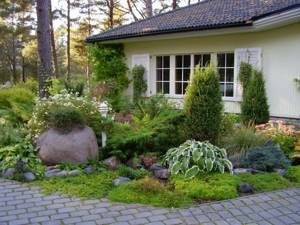
To decorate the front garden in front of the house, different types of perennials are suitable - both lush rose bushes and unpretentious gaillardias. You can use other types of ornamental plants, as well as plant fruit crops. Such plants help maintain the appearance of the front garden unchanged for several years in a row. Among perennials, the following are most often planted in front gardens:
- Peonies - planted for continuous flowering, as a stage between bulbous and daylilies.
- Rudbeckias are yellow inflorescences that can complement any style.
- Hydrangeas are long-lasting bloomers that create an atmosphere of romance in the front garden.
- Hosta is a plant that grows well in shaded areas.
- Delphinium is an erect inflorescence that is used to provide a background for low-growing flowers.
How to build it yourself
It would seem that the front garden is nonsense! But it's not that simple. Its construction requires strength, patience and skills in working with tools. Let's divide all the work into several stages.
Stage 1 - Drawings, measurements, sketches
One of the important stages is the preparatory stage, since at the planning stage it is possible to eliminate those errors that may arise in the process of creating a front garden.
Before we begin construction, we perform the following actions:
- Visualization. You need to imagine the object in your imagination, think through all the nuances to the smallest detail. Answer questions such as:
- Why do you need a front garden in front of the house?
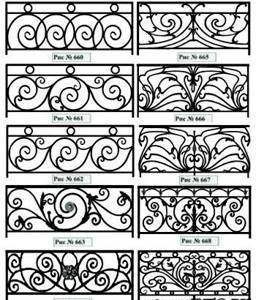
A selection of sketches and patterns for the front garden fence
When performing all these steps, you need to take measurements as accurately as possible, since they will be used to calculate the amount of building material needed and their cost.
Stage 2 - Purchase of materials
Based on the data obtained in the fence drawings, the material is purchased in the required quantity. A wrought-iron fence installed in front of a house should be as safe as possible for people, especially if there are children in the house (do not contain sharp peaked edges that can be bumped into).
You can purchase both finished products and make them to order. The cost of the products depends entirely on the configuration and complexity of the forged pattern: the simpler it is, the more profitable it is.
Stage 3 - Construction
Building a front garden with your own hands is within the power of every person. However, it is worth considering that a forged fence has quite an impressive weight, this can cause a lengthy installation. Therefore, if forged fencing is too heavy, you will have to add a construction hoist to your arsenal of usual tools. In the case where the soils on the site are prone to movement, it would be advisable to lay a foundation.
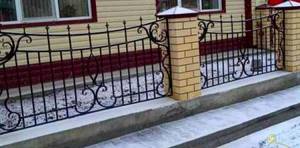
Construction of a foundation and pillars for a wrought-iron front garden
Next, everything is poured with concrete mortar and allowed to dry for about a week in hot, dry weather. If it is not planned to build a foundation, forged elements of fences are planted in the ground, or rather not the prefabricated structures themselves, but support pillars that hold the load. When the foundation is ready, support pillars are installed (with your own hands or with the help of specialists) on which the fences will be attached. They can either be immersed in the foundation or mounted separately.

Decor and design of wrought iron fence
When the soil is ready and all the necessary manipulations with the plants have been done, all that remains is to secure the forged fences in front of the house.
It’s not difficult to do the installation yourself; just attach the individual elements with special fasteners and the front garden is ready. In some cases, the structure is welded to support pillars. This way the metal will have better adhesion, and the fence itself will last longer.
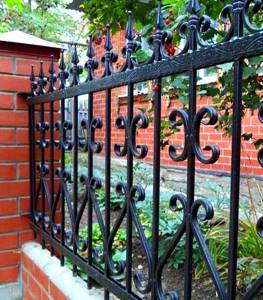
Attaching a forged fence section to brick pillars
Stage 2 – Procurement of materials
Based on the data obtained in the fence drawings, the material is purchased in the required quantity. A wrought-iron fence installed in front of a house should be as safe as possible for people, especially if there are children in the house (do not contain sharp peaked edges that can be bumped into).
You can purchase both finished products and make them to order. The front garden in front of the house is a photo made from a picket fence? The cost of the products depends entirely on the configuration and complexity of the forged pattern: the simpler it is, the more profitable it is.
Tips and tricks
It is necessary to take into account such nuances as:
- The metal from which the fence is made will last a long time only if it is treated with an anti-corrosion substance before painting.
- This type of fencing for a front garden is considered the most expensive in terms of cost, but the most reliable in terms of quality indicators.
- It is better to choose high-quality paint for fencing, since it completely determines how long the fence will last without repair.
- A foundation is needed only when the fence is heavy and large in size. If the parameters of the fence are small, it is quite enough to concrete the support pillars.
Features and types of forged fences
Reliable and elegant wrought iron fencing
It is no secret that a wrought iron fence or front garden can be called one of the most sophisticated and stylish types of fencing for a country house. Having a respectable appearance, it can not only decorate the territory of private houses, but also reliably protect the property of the owners from intrusion by unauthorized persons.
The only drawback of hammered metal structures is their fairly high price, which is quite justified. Indeed, as a result of the work of a whole team of specialists, including engineers, designers, architects and blacksmiths, an exclusive work is obtained that has no analogues in elegance and beauty.
Purpose
The main task assigned to the original fences is decorativeness. The performance of protective functions for such structures takes last place. It is thanks to this property that every summer resident has the opportunity to create a spectacular front garden from what is at hand. Analogs of decor used in other corners of the summer cottage will make it easy to create the integrity of the picture. A successful combination of a small fence with a permanent fence or a country house can become a harmonious landscape design solution.
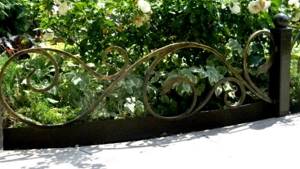
Front gardens are designed to perform a number of tasks:
- protection of the internal territory from domestic animals and birds;
- as boundaries for zoning the space of a summer cottage;
- often act as supports for graceful climbing flowers;
- as an effective decorative element.
Material for production
Not the last place in the visual perception of the overall picture of a summer cottage is occupied by the shape of the fences and the material for their manufacture. The material for beautiful front gardens should be chosen based on the following criteria:
- original appearance;
- high performance;
- ease of installation and dismantling work with your own hands;
- final cost;
- ease of care and maintenance during operation.
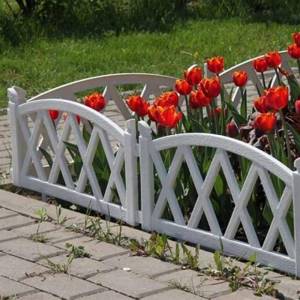
The following materials are often used for luxurious front gardens:
The harmonious combination of several materials gives the front garden special features and properties. As an example of an effective solution, the fence for the front garden is shown in the photo above.
Variety of metal structures
Wood is an environmentally friendly material and is often used to make various fences and fences. However, such a fence requires annual maintenance and periodic necessary repairs. From a practical point of view, durable metal fences are always a priority.
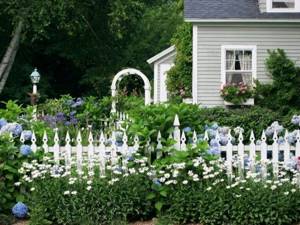
Metal fences for front gardens are represented by a number of materials:
- corrugated sheeting;
- artistic forging;
- metal picket fence;
- Rabitz.
Wrought iron fences for front gardens perform not only decorative functions, but are also very practical to use. The use of forged elements in combination with other materials will add sophistication and luxury to any fence.
Manufacturing technology
Sketch of a sectional welded fence with forging elements
There are several ways to make fences and front gardens from forging. The simplest and most inexpensive of them is to weld metal structures according to the drawings.
Real forging differs from other methods in that all work is done by hand. This option for making a fence is not the most common, as it is labor-intensive and time-consuming. The production and fastening of elements to each other occurs using a hammer.
The most popular and affordable option for making beautiful embossed fences is the forged-welded method. In this case, ready-made elements, for example, strips and rods, according to the drawings, are combined into a structure in various simple ways.
Any of the methods by which forged fences and front gardens are made requires craftsmen to have non-standard design ideas and the ability to do their work efficiently.
Decorative forging
Forged parts in the exterior of a summer cottage look impressive and fascinating. Fantastic curls of a bizarre shape look charming and create the impression of unity with nature. Forged front gardens are especially impressive in combination with climbing vegetation, as in one of the examples in the photo.
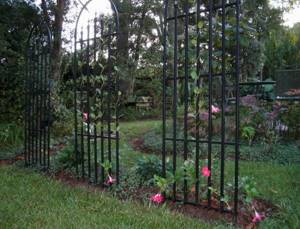
Decorative forging looks great against the background of numerous bright colors, elegant buildings, as well as in various miniature compositions of a summer cottage.
Advantages of front gardens with forging
Forged front gardens can rightfully be called real artistic paintings, because each decorative element occupies a specific place and allows for harmonious visual perception.
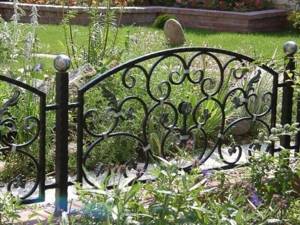
Forged fences have many advantages over other fences:
- ease of care and maintenance;
- long period of operation without the need for annual repairs;
- strength and reliability of the material;
- environmental Safety;
- resistance to negative natural influences;
- unique compatibility with other types of materials;
- elegant appearance.
DIY wrought iron fence
Forged metal fences are essentially rods placed at a distance from each other. Thus, an elegant openwork design is obtained. The rods are made round or faceted (most craftsmen prefer working with faceted rods).
First, the frame is made. To ensure that its angles are strictly 90 degrees, the frame is made on a flat surface to which the frame fits tightly. Next comes the most creative stage - choosing a pattern combination. This is a very exciting process because there are a huge number of all kinds of curls, petals, spirals, rings and other decorative elements.
Manufacturing of forged front gardens
The birth of spectacular forged front gardens occurs in one of three options:
- Standard forged front gardens are the most affordable variety and are welded structures, for the manufacture of which standard patterns are used. Ready-made templates greatly simplify the execution of decorative elements and speed up the execution of work.
- The most expensive option is decorative forging, made according to exclusive sketches. Forged parts of a metal front garden in such cases are made in a single copy and have no analogues.
- Often in summer cottages there are combined structures, for the molding of which standard patterns are used and several individual elements are added to the overall picture. They allow you to bring any design solutions to life and fully solve the assigned tasks.
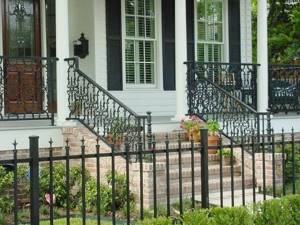
The cost of forged front gardens depends on:
- difficulties in manufacturing decorative elements;
- their required quantity;
- material quality;
- from the forging method.
To make original fences, one of the following types of forging is used:
- cold, which is the most affordable option;
- hot, allowing you to implement individual projects of any complexity.
Manufacturing front gardens using the hot forging method, as a rule, costs several times more than the first option.
Types of materials for fences
If you look at the photos of forged front gardens in front of the house, then almost any option looks presentable.
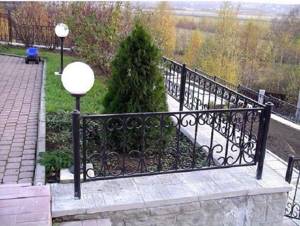
However, fences are also made from other materials. When choosing them, a number of important factors are taken into account:
- long service life;
- aesthetic appearance;
- affordable price;
- ease of installation;
- easy care.
Most often, fences for front gardens are made from the following materials:
- Metal. In addition to forged fences, chain-link fences also fall into this category. Recently, it has been fashionable to fence front gardens with a picket fence made of corrugated board. The advantage of the latter material is its low weight and resistance to corrosion. It is better to use galvanized chain link. Otherwise it will have to be painted.
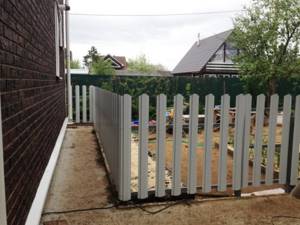
- Tree. The material is popular among summer residents due to its availability and ease of processing. The standard option is a picket fence. Craftsmen create real masterpieces - carved front gardens. Their appearance can compete with wrought iron fences. However, a huge disadvantage of wood is its short service life and loss of its presentable appearance due to exposure to the natural environment.
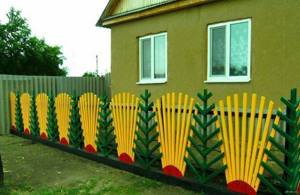
- Plastic. Gardening stores have a huge selection of decorative fences made from different types of plastic. They have practically no protective function, but simply serve as decoration for the front garden. They help to delineate the area. Plastic is not afraid of water, but fades in the sun. Over time, the fence becomes fragile and breaks from accidental impacts.

- Natural stone. Front gardens are rarely fenced with one stone, because a solid fence will cover all the beauty of the site. The base and supports are often built with cobblestones, and forged gratings are placed between them on the spans.
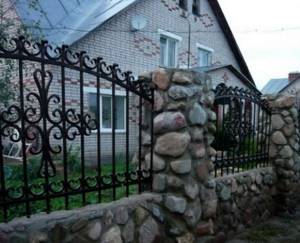
- Decorative brick, concrete blocks. The material is similar to stone. A heavy fence requires a reinforced foundation. If you use non-decorative brick or concrete blocks, they will have to be faced with plaster or decorative stone. The spans between the supports are similarly filled with forged gratings.
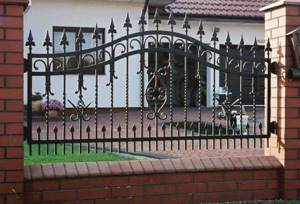
- Recyclable materials. This group of materials includes car tires, bottles, pottery and other household items. The owner decorates the front garden at his own discretion and develops his imagination.
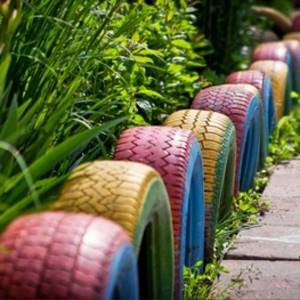
- Often in summer cottages there are front gardens with hedges. The owners plant climbing plants near the net, and they completely braid it.
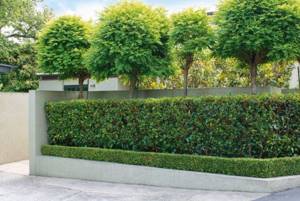
The video shows an example of a fence for a front garden:
Selection of fencing
Before ordering and building forged front gardens, you need to draw up a project and answer a number of questions:
- desired height;
- width of individual sections;
- design features of the fence;
- exclusive or standard option for manufacturing decorative parts.

Installation of fences for front gardens with forged elements is carried out on a pre-installed foundation or strong support pillars. To carry out construction work, it is better to involve qualified specialists, because installing a front garden with forged elements requires a professional approach and special equipment. The final stage of construction work should be the mandatory cleaning of welds, disinfection of the surface and treatment with protective anti-corrosion agents.
Perennial climbing plants and flowers, some photos of which are presented below, will help to effectively decorate wrought-iron fences for the front garden. For this use:
- Sweet pea.
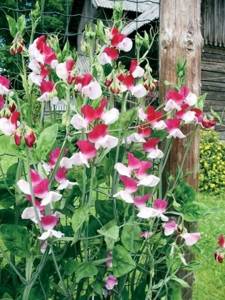
- Grape.

- Clematis.
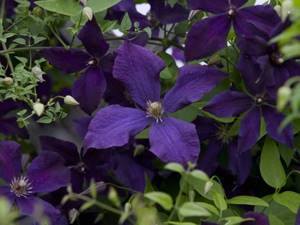
- morning glory

There are many other options to choose from.
The purpose of the fence for the front garden
When planning to make a fence for the front garden, attention is paid to two main aspects: the properties of the material and the shape of the structure. The choice depends on the assigned functions, whether it will be a purely decorative element or the fence is intended for protection. Often, flower garden fencing performs several tasks simultaneously.
A palisade fence that matches the main fence or building will help achieve a harmonious landscape design. If the fence of the entire area is made of corrugated board, it would be logical to install a miniature fence around the flower bed made of a similar material. The presence of a tree in the design of a house or fencing a common area brings wooden fences for the front garden to the fore. Despite the variety of types of fences, forged front gardens are characterized by the greatest practicality in combination with decorativeness.
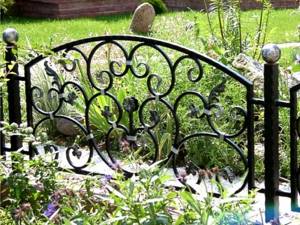
When choosing a particular design, the priority functions assigned to the fence are taken into account. Will it be:
- protecting the front garden from pets;
- a fence as an element of zoning the territory of a site;
- support for climbing plants;
- purely decorative element.
Beautiful fences, including wrought-iron front gardens, are pictured below:
What is a front garden
The main decoration of the plots are flowers and green ornamental vegetation. For planting, special places are allocated where flower beds are laid out. One of them is a piece of land in front of the building. The visible place is called the front garden. The most beautiful flowers are always planted here. The front garden acts as the face of the yard, which means that special fencing is also required. An excellent option is a beautiful wrought-iron front garden, painted black, bronze or silver.

The fence protects the area from the entry of uninvited guests, and at the same time does not obstruct the view of growing ornamental plantings. Depending on various factors, the height of forged front gardens has a wide range. There are low fences of about 30 cm, as well as large three-meter fences. The structure consists of metal spans supported by supports. Due to the impressive weight of forged front gardens, the distance between the pillars is small. The parameter depends on the height of the fence. Additionally, the density of the location of metal elements along the span and their thickness are taken into account.
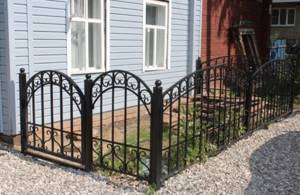
There are four important requirements for fencing a front garden:
- ensuring reliable protection of the site from uninvited guests;
- attracting attention to the design of the front garden and growing flowers;
- harmonious combination with the architectural ensemble;
- providing safe access to the front garden to the owners of the site.
A variety of forged fences allows you to beautifully decorate the front garden of any private yard.
Characteristics of materials for fencing the front garden
When choosing material for fencing a flower garden, they are guided by the following criteria:
- performance properties;
- aesthetics;
- fencing cost;
- ease of installation;
- ease of care.
At the same time, do not forget about the harmonious combination with other elements of the site. The fence for the front garden can be made of the following materials:
- Metal. Characterized by extreme practicality. Depending on the chosen category of metal, the price range is quite wide. For a budget fencing option, a chain-link mesh is suitable, while a forged structure will create an atmosphere of aristocracy and sophistication. Strength and durability are the key advantages of metal fences. To avoid rust, choose a material with an anti-corrosion coating or treat the surface yourself with protective agents.

- Tree. Among the advantages of the material are simple installation and the possibility of further replacement of failed elements. A creative approach to the painting process can give a fence a whimsical or sophisticated appearance. The affordable price is another plus of wooden fencing.
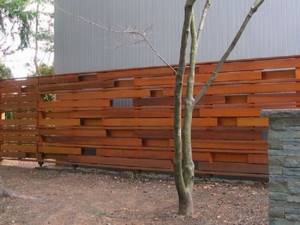
- Plastic. A relatively new material that is used to make fences. Cheapness and resistance to moisture are attractive features for a front garden fence. It is used mainly for decorative purposes. You should be prepared for color loss when exposed to the sun's rays.
- Stone. Natural material is valued for its durability and aesthetics. You can decorate your front garden with a fence made of stones yourself. The difficulty is the transportation process and installation time. High cost is the main obstacle to the widespread use of stone as a fence for the front garden. Moreover, to perform the protective function it will be necessary to combine it with a metal fence.

- Concrete and brick. They have sufficient resistance to precipitation, but the materials are less aesthetically pleasing compared to natural stone. The process of creating a fence is quite labor-intensive; the amount of work largely depends on the height of the structure. Fencing a front garden made of brick or concrete is used if there is leftover material after the main construction.
- Recyclable materials. The most democratic option for fencing a flower garden. The range of materials is unlimited. Car tires, plastic bottles, clay pots or plates - it all depends on the imagination of the owner of the front garden. Lack of material costs and ease of installation are the main advantages of available tools. In addition, they are all resistant to negative external factors.
Classic and non-trivial solutions for fences for the front garden are presented in the photo gallery:
Criteria for choosing a forged fence
Fencing with forged elements decorated with polycarbonate for less viewing
For the production of decorative forged grilles and front gardens, various materials can be used, namely cast iron, iron, steel, ferroalloys. With the right choice of material, a wrought iron fence can last for decades without damage.
It should be borne in mind that usually only cast elements are made of cast iron, and not the grate itself. Therefore, offers to produce beautiful cast iron fencing at a low price are often unfounded. Sometimes materials such as titanium, copper, aluminum are used to decorate the spans of the lattice with thin details, which significantly increases the cost of the fence.
To make a wrought iron fence more durable, you can increase the number of decorative elements in the spans. The most acceptable fence height is two meters.
Since the drawings of the pattern for the future fence are developed in a three-dimensional format, when choosing a fence you should evaluate its appearance from all sides, and not just from the face. It is best not to try to develop your own new untested drawing, but to listen to the advice of professionals. This will help save time and money.
If the new forged fence seems too transparent, you can add polycarbonate plates as protection from prying observers.
Variety of metal structures
The beauty and environmental friendliness of wood is undeniable, but from a practical point of view, a metal fence for the front garden wins. Forged fences successfully combine high performance properties with decorative properties. The variety of metal structures is represented by the following types of fencing:
Forged fences
Front gardens decorated with wrought iron fences are extremely elegant. Stamped fencing elements are presented in specialized stores; an individual order from a craftsman will help you become the owner of an exclusive fence. Depending on the height of the fence, it can serve a purely decorative function or become a reliable protection for the front garden from animals.
Construction stages
The assembly of a wrought-iron fence for the front garden occurs in several stages:
- for a massive structure, a foundation is poured, but a decorative fence does not need it;
- install support pillars by driving or digging them into the ground;
- attach section panels to the racks;
- paint the building.

Measurements and drawings
To assemble 1 section, 2 measurements are taken: the length and height of part of the fence. Using these parameters, the frame for the openwork fabric is welded.
If you plan to purchase ready-made sections, then first measure the entire perimeter of the fenced area, and then divide the result by the length of the products you like. This is necessary in order to buy a whole number of fence parts and avoid cutting one of them. Fractional values when calculating the result are rounded down, and the remainder is divided by the number of sections, adding a few centimeters to the gap between them and the columns.
Materials and tools
To work you will need:
- ready-made fence elements or rods, corrugated pipes, etc. - for making fabric with your own hands;
- welding machine;
- pillars for the base of the structure, section 5-7 cm, depending on the purpose of the fence;
- a drill or shovel to install supports;
- for a large heavy fence - foundation materials (cement, sand, crushed stone or stone for filling the hole);
- measuring instruments.
Foundation
Decorative products can be installed without a foundation. Light fence posts for a front garden are driven into the ground using a sledgehammer if they do not have decorative tops. Beautifully designed posts are best dug or placed in recesses made with a hand auger (for piles). The gap between the walls of the pit and the pipe is filled with concrete mortar or clogged with stone chips.

A massive wrought iron fence for the front garden needs a foundation. This is especially necessary on heaving and deeply frozen soils. The base is also made for the parapet, choosing a strip type of structure. Pouring is done into the ditch, filling it to the soil level. The support columns are poured into concrete at this stage. After hardening, the above-ground part of the parapet is cast or laid out.
On stable, dense soil, the foundation can be poured under each rack separately:
- drill or dig a hole 0.5-1 m deep;
- strengthen the post in it, aligning it with a plumb line in 2 planes;
- fill the hole with concrete or crushed stone, compacting the layers of stone as you fill it;
- check the verticality of the post again in 2 planes and correct the defects.
Installation
You can install a forged front garden with your own hands in different ways:
- Ready-made purchased products often have loops and corresponding pins. Such structures are the easiest to assemble: sections of forged front garden fencing are placed on posts.
- The connection of finished parts can also be done using a welding machine. Purchased or ordered sections have protruding ends of horizontal parts that are welded to the installed posts.
- If you make stone pillars with your own hands (with a frame made of pipe inside), then the fastening element for the fence sheet is installed during the installation of the support pipe: you need to weld a piece of pipe, angle or rod onto it, the ends of which will protrude beyond the outer boundaries of the masonry. A section will then be welded to these mortgages.
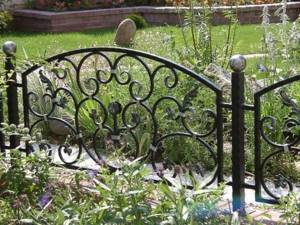
Types of wooden fence
Wooden fences for the front garden are designed to maintain closeness to nature. Despite the low practicality of wood as a fence, it is still popular due to its aesthetic appearance and variety of designs.
Fence
Due to the ease of creation, the picket fence has become widespread. Short boards are the main element of a wooden fence. A non-trivial approach to painting the fence helps to add individuality to the front garden. They are also experimenting with the height of individual fencing elements: the planks can be the same length or form a fence with wavy outlines. The principle of creation is similar to a metal picket fence:
- Initially, the installation of support columns is underway;
- then horizontal strips are attached;
- Finally, the vertical planks are fixed.
A lattice structure is more difficult to manufacture when the fence boards are installed diagonally and intersect each other. When choosing a fence for the front garden, you should remember that thin planks look more elegant and attractive, and flowers need gaps in the fence of sufficient width to allow sunlight to enter.
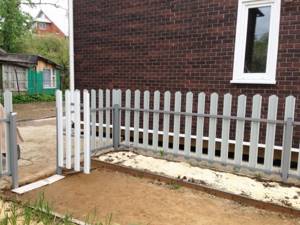
A front garden fencing made of timber looks somewhat massive and is used less frequently than a classic picket fence. The reason is the complexity and high cost of the idea. Experience in wood carving allows you to create real masterpieces with figured columns or intricate patterns.
A timber fence looks most harmonious in combination with a log house. In addition to timber, birch poles or exotic bamboo are used to create a front garden fence. The choice depends on the overall architectural concept and stylistic orientation of the landscape design.
Wattle
The fence will allow you to plunge into the atmosphere of a village of the last century. The basis of the front garden fence is:
- willow twigs;
- hazel;
- vine;
- young shoots of cherry or apple trees.
Experienced craftsmen perform elegant openwork weaving when decorating the front garden fence. Examples of various wooden fences for the front garden are shown in the photo gallery:
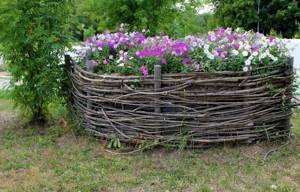
Wrought iron fence: advantages and types of construction
A front garden built from metal has undeniable advantages, especially when comparing metal and other building materials. Among these advantages:
- Strength and durability. Forged metal structures are very reliable and will serve you for a long time, no matter what the weather. Forged fences will be able to withstand many mechanical impacts, even a machine impact;
- Home security. That’s why we put up fences to protect our home and loved ones from uninvited guests. And the high sharp peaks that can be crowned with fences will instill fear in anyone;
- Easy maintenance. In technical terms, metal fences are among the most unpretentious, because they do not require frequent cleaning and painting;
- Design variety. You will not spoil the appearance of your site with a wrought iron fence, because there is a wide variety of ideas and ideas.
The listed advantages show that a wrought-iron fence can either become an accent in your yard or gently emphasize features.

Wrought iron fence - beautiful, practical, and reliable
Types of forged fences
Wrought iron fences can be divided into the following types according to their structure:
- Security fence. These are solid metal modules or sections welded together. They can be assembled simply and quickly and are quite durable and at the same time beautiful;
- Decorative fence. This is a job for a master. Painstaking work based on individual drawings has a high price, but it also looks the part;
- Combined fence. This is the result of combining two types of fences - protective and decorative. That’s why such a fence looks massive and at the same time aesthetically pleasing.
It is worth noting that a metal fence is not only forged curls. This is also:
- Rabitz. Installs very quickly. Apart from the mesh and the posts on which the mesh is attached, no additional materials are needed. The chain-link mesh will prevent animals from spoiling the front garden and at the same time will not obscure the flowers. Of course, the chain-link mesh has a budget look, but this can be corrected by planting weaving flowers along it. By the way, today there are different colors of metal mesh, and thanks to the galvanized coating, such a fence will not rot or rust.
- Profiled sheeting. Metal sheets are quite easy to assemble, but will completely obscure the beauty of the flower bed. The variety of thickness and color of corrugated sheets makes it possible to install a special fence. Modern manufacturers offer metal sheets with a printed pattern that can imitate any material.
- Metal picket fence. Elements on such a fence can be positioned vertically, horizontally and even diagonally. The material is available in different colors. A metal picket fence will always look special to every owner, despite the apparent uniformity of its shape.
- Profile pipe. For such a fence a foundation is required. Pipes can be thin or thick walled and can take any shape.
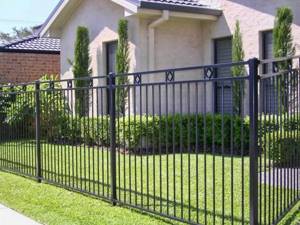
Wire fence
Other types of fencing
In addition to traditional wood and metal, other types of fencing are also used when creating a fence for the front garden.
A natural stone
A fence made of natural stone can compete in expressiveness with a forged structure. Stonework looks impressive and laconic. The stones are connected to each other with cement mortar. Such front garden fencing fits harmoniously into various styles of landscape design.
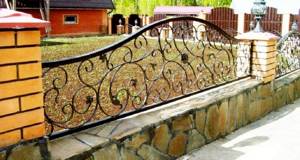
Relatively recently, a new type of fencing has appeared that uses stones - gabions. The design is a durable mesh frame filled with stones. The massiveness and high cost of the fence is the main reason for its limited use as a fence for the front garden.
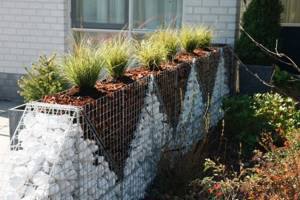
Painting a stone fence with luminescent paints can add exclusivity to a landscape design. Such a fence will emit a muted glow in the evening. The following types of natural stone are used as front garden fencing:

Concrete and brick
The front garden fence made of ready-made concrete panels combines practicality and decorativeness. But the massiveness of the structure creates difficulties during transportation, unloading and installation. It is impossible to cope with such a fence alone.
Fewer problems arise when designing a brick fence for the front garden. But building a fence requires skills in working with brickwork.
Fencing a front garden with concrete or brick structures requires preliminary preparation of the foundation.
Plastic and other recyclables
The high performance characteristics of plastic were the reason for using the material as a fence for the front garden. Light weight and easy installation, a variety of colors and shapes are attractive features of plastic fencing. Installation does not require additional labor.
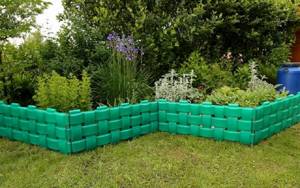
The means at hand will help you save your budget when decorating a fence. Car tires painted in bright colors or plastic bottles play an exclusively decorative role. There is no need to talk about protective functions here.
